Learn how to make tie dye macarons (French style) with American buttercream. These marbled macarons are perfect for dessert, a birthday party, or a graduation (customize with school colors).
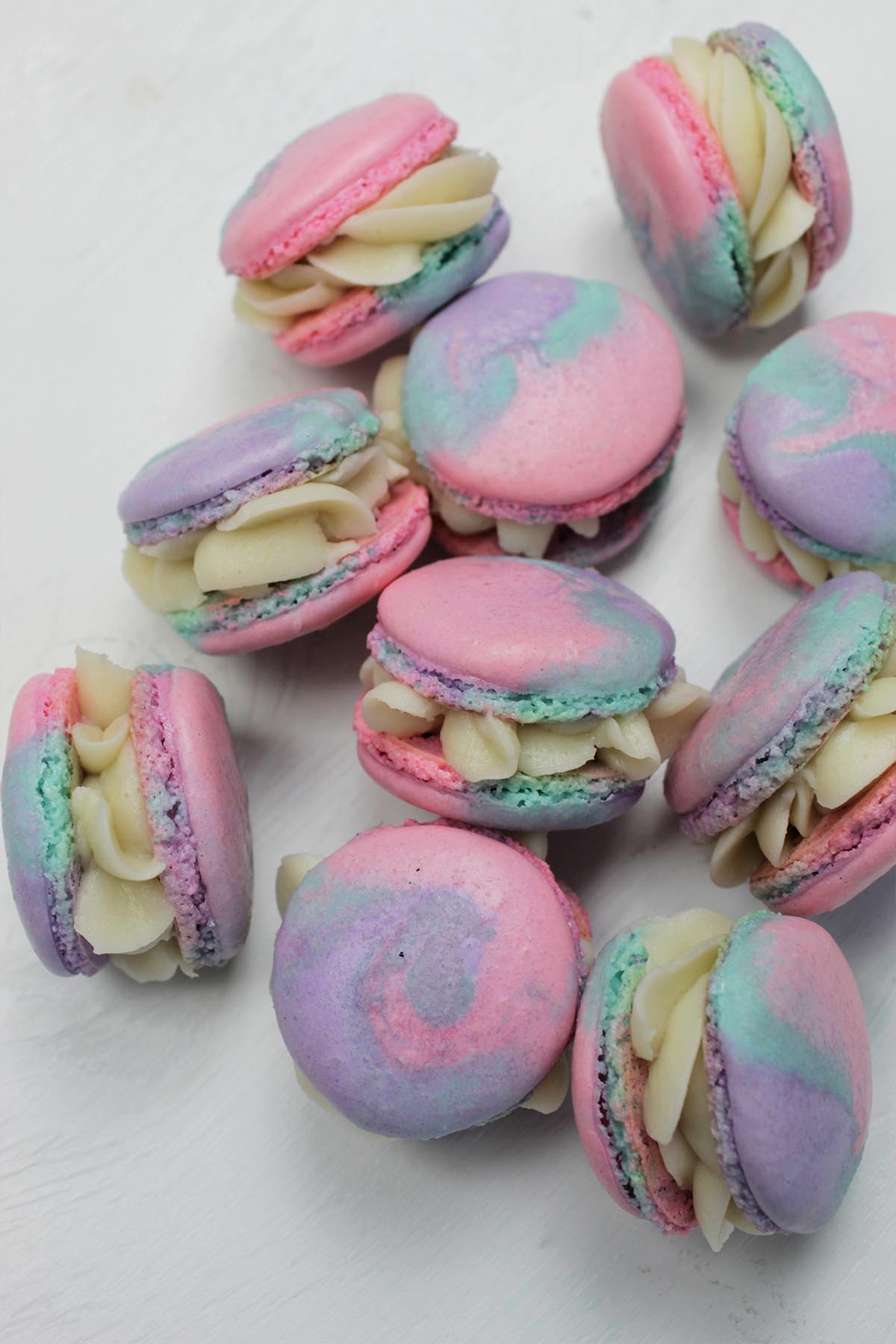
Want To Save This Article?
Enter your email below and we'll send it straight to your inbox. Plus, you'll receive new weekly recipe inspiration.
French macarons are one of the most beloved desserts! They're light, not too sweet, and the perfect little treat.
If you've ever tried making macarons at home, you know they can be tricky and sometimes really frustrating. Today, we are making tie dye macarons, which are a fun spin on the classic French macaron.
Even if you've made macarons in the past and had trouble, I want to help guide you through the process so you can finally master how to make French macarons.
Be sure to check out the macaron troubleshooting guide and video for additional help. As always, feel free to leave comments, so I can try to help you with any possible mishaps.
Jump to:
What You'll Learn In This Recipe
- How French macarons vary from other styles of macarons like Italian and Swiss macarons.
- The two most important steps to get correct in order to bake perfect macarons.
- Troubleshooting steps to try if your macarons aren't turning out correctly.
Enjoy learning tips about making macarons? Sign up for my free macaron template and email series. You'll learn my favorite tricks for achieving perfect macarons.
What are French Macarons
First things first, you need to know: what is a French-style macaron?
Macaron (pronounced as ma·kr·aan) is a meringue-based dessert made from egg whites, confectioners' sugar (icing sugar), almond flour, and granulated sugar. And, just so we're clear, macarons and macaroons (an American coconut cookie) are NOT the same thing!
You'll often hear macarons called 'French style macarons' and that's due to the style of meringue used in the recipe. Meringue can be made using a French, Italian, or Swiss style. Therefore, macarons can also be made in these three styles.
Ingredients You Need
Here are the ingredients you'll need to make tie dye macarons.
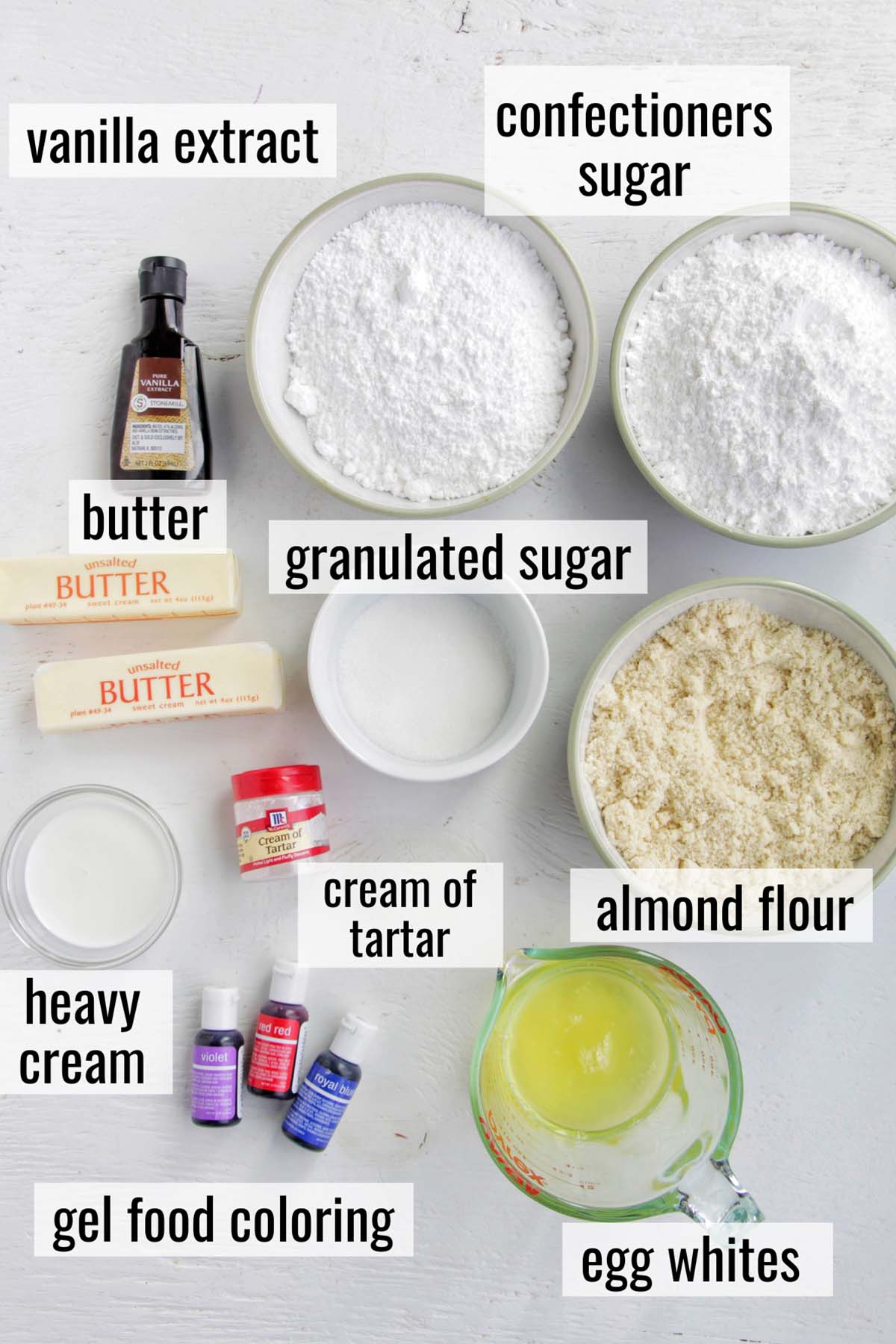
For the macarons, you'll need:
- Egg whites: Egg whites are the base of the meringue. Make sure you allow the egg whites to come to room temperature before whipping the meringue.
- Granulated sugar: While making the meringue, you'll add in granulated sugar. It helps to build up the structure of the egg whites.
- Cream of tartar: Adding an acid to the meringue helps to stabilize the egg whites.
- Super fine almond flour: This ingredient is made from almonds that are ground into a fine powder. Almond flour adds a subtle but delicious flavor to macaron cookies. Make sure to purchase high-quality almond flour.
- Confectioners' sugar: This is another one of the dry ingredients used in macarons. Confectioners' sugar is sifted together with the almond flour that helps to create a smooth shell.
- Gel food coloring: Liquid food coloring will not work. Be sure to use a gel or powdered food coloring. In order to achieve the tie dye marbled effect, you'll need to pick three different colors.
Learn more about the ingredients for macarons and a little bit of the science behind each ingredient.
For the American-style buttercream, you'll need:
- Unsalted butter: Using unsalted butter allows us to control the amount of added salt in the buttercream.
- Confectioners' sugar: For a silky smooth buttercream, take the time to measure it out, then sift the confectioners' sugar.
- Heavy cream: Heavy cream helps to thin out the buttercream. You can substitute with half and half or whole milk if needed.
- Vanilla extract: This ingredient adds just a bit of flavor to the buttercream. You can also use vanilla bean paste as a substitute.
How To Make This Recipe
Prep Work
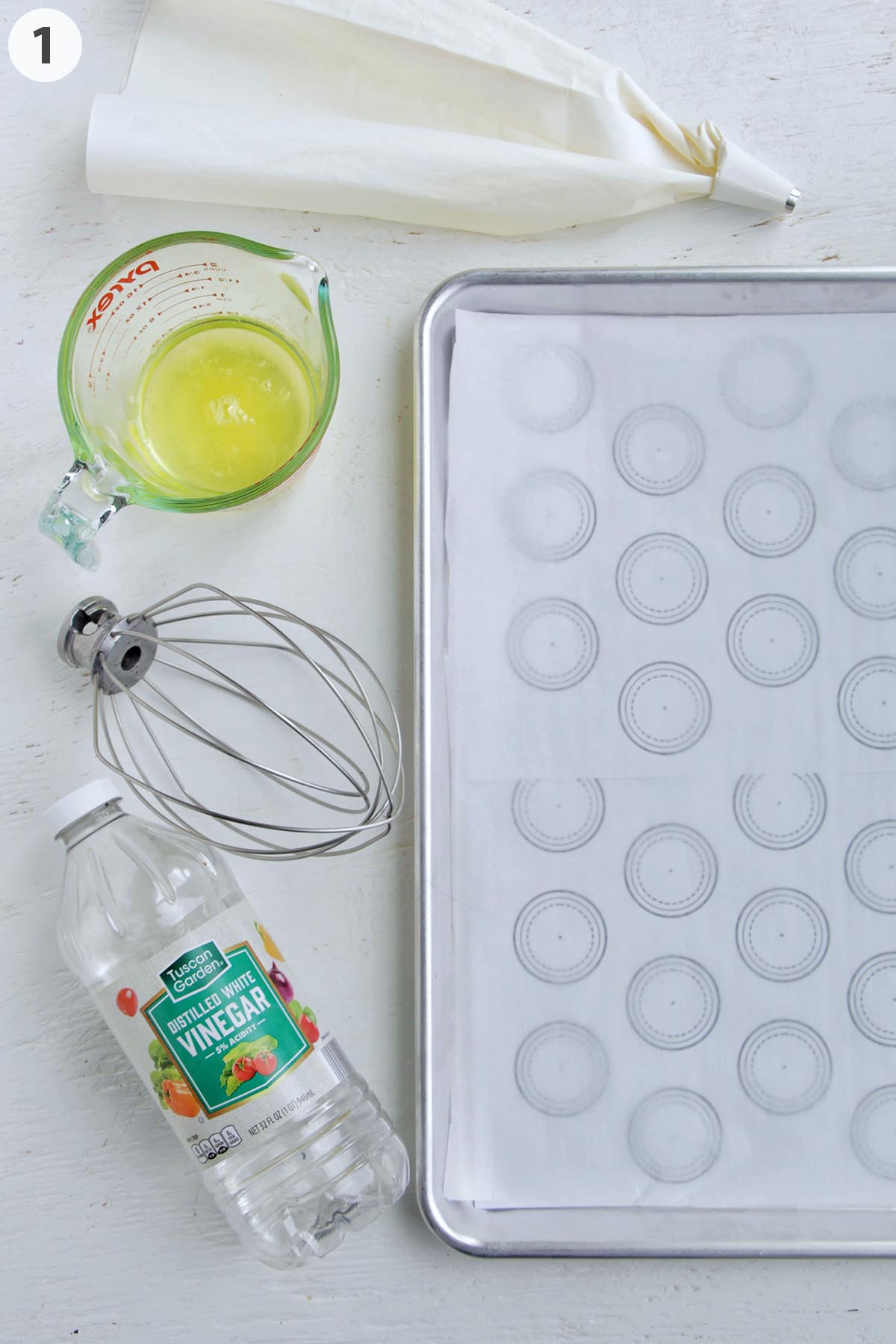
The first step to making tie dye macarons is mise en place. This is a French term that means 'to put in place.' It's the term chefs use to make sure they have all of their ingredients and equipment set up.
Here are the tasks you'll need to complete before baking:
- Separate the egg whites from the yolks. Allow the egg whites to come to room temperature.
- Measure the dry ingredients using a kitchen scale. Sift the almond flour and confectioners' sugar together in a large bowl. This step ensures you have macaron shells without bumps.
- Wipe down all bowls and the whisk attachment with a little white vinegar on a paper towel to remove any leftover oils. Oil will destroy your meringue, so it's important to use an acid to remove any potential oil build-up.
- Print off a macaron template. Place the template on a sheet pan underneath a piece of parchment paper.
- Prepare your piping bag with a round ½ inch tip. Push part of the side of the piping bag into the piping tip to ensure nothing leaks out. Set the bag inside a tall glass, and pull the remaining top of the piping bag out over the outside of the glass to make pouring the batter easy and clean.
Make The Meringue
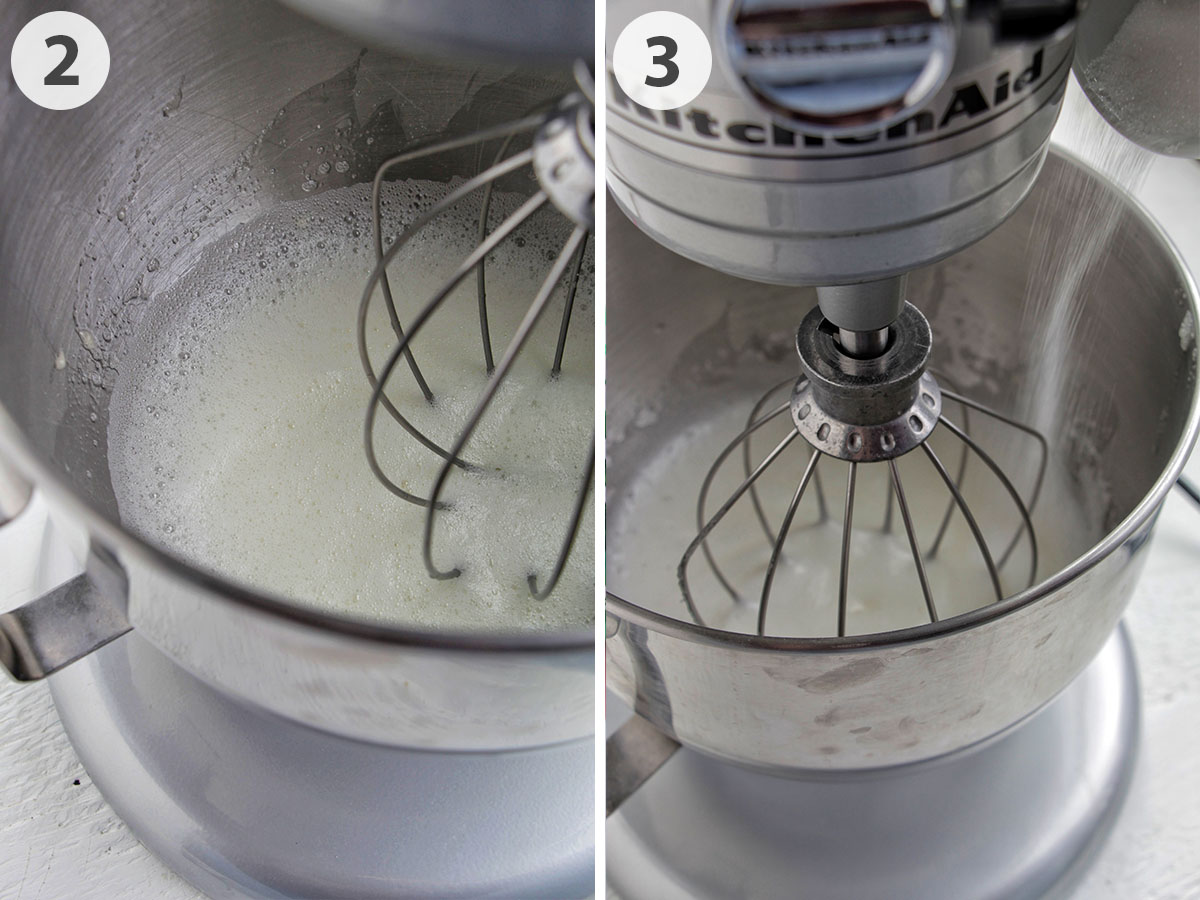
Next, it's time to make the French-style meringue.
Add room temperature egg whites to a large bowl, along with the cream of tartar. Whip on medium-low speed with an electric or handheld mixer until the eggs are very foamy.
Then add ⅓ of the granulated sugar at a time, and increase the speed to medium-high. Adding the sugar slowly allows the egg whites time to stabilize and form a strong network.
Once all the granulated sugar is incorporated, allow the egg whites to continue to whip up on medium-high speed (around 7 or 8 on a KitchenAid mixer) until stiff peaks form.
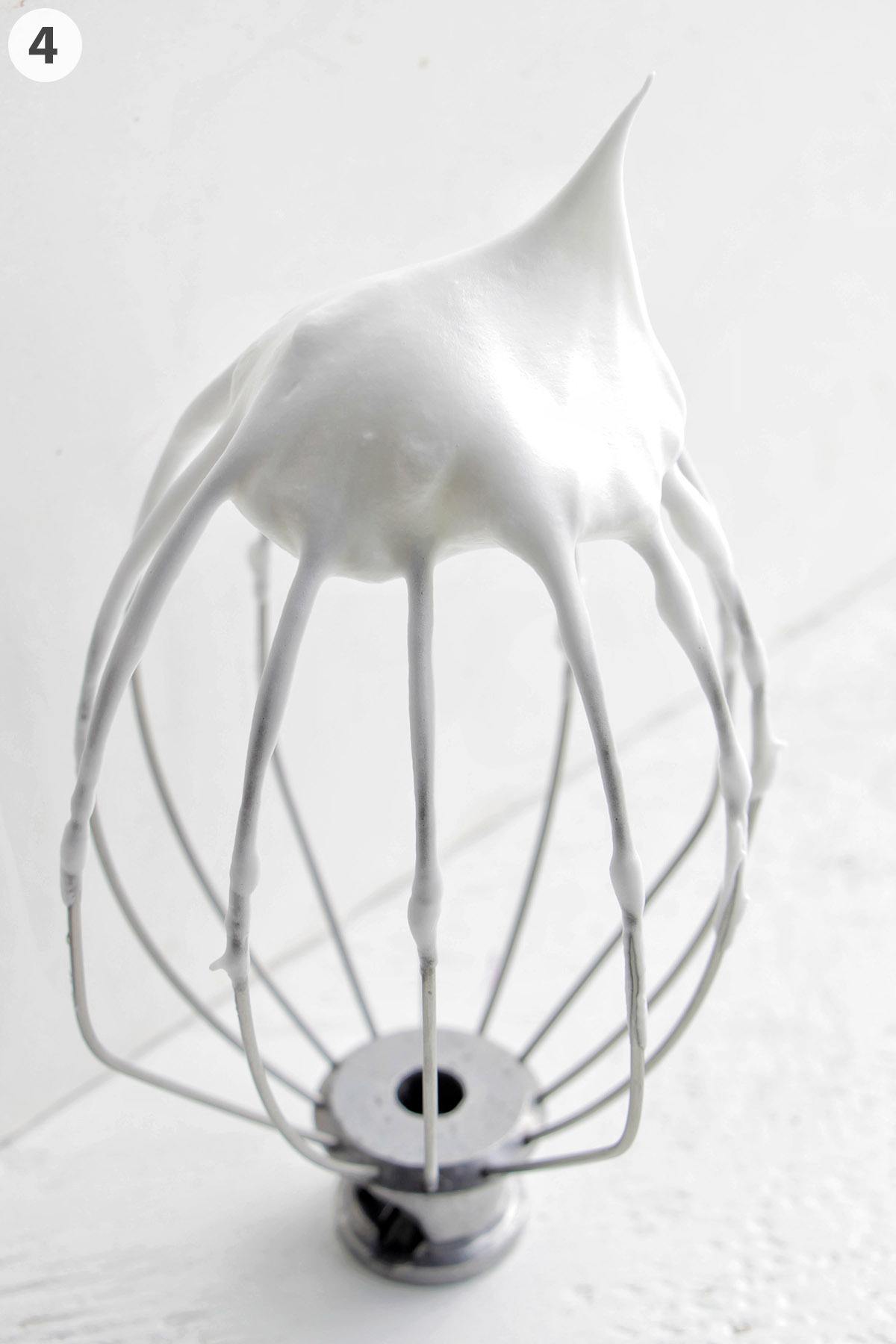
It's really important to make sure your meringue has reached stiff peaks. If your meringue is under-whipped or over-whipped, your macarons will not turn out correctly.
Here are some visual cues you can use to know that your meringue has whipped to stiff peaks:
- You'll notice the meringue starts to ball up inside the whisk while it's mixing.
- Pull the whisk out of the mixer. A stiff peak should stand straight up (no curl at the tip).
- You can fully flip the bowl over and nothing moves or falls out.
- The meringue feels sturdy (not flimsy).
Macaronage
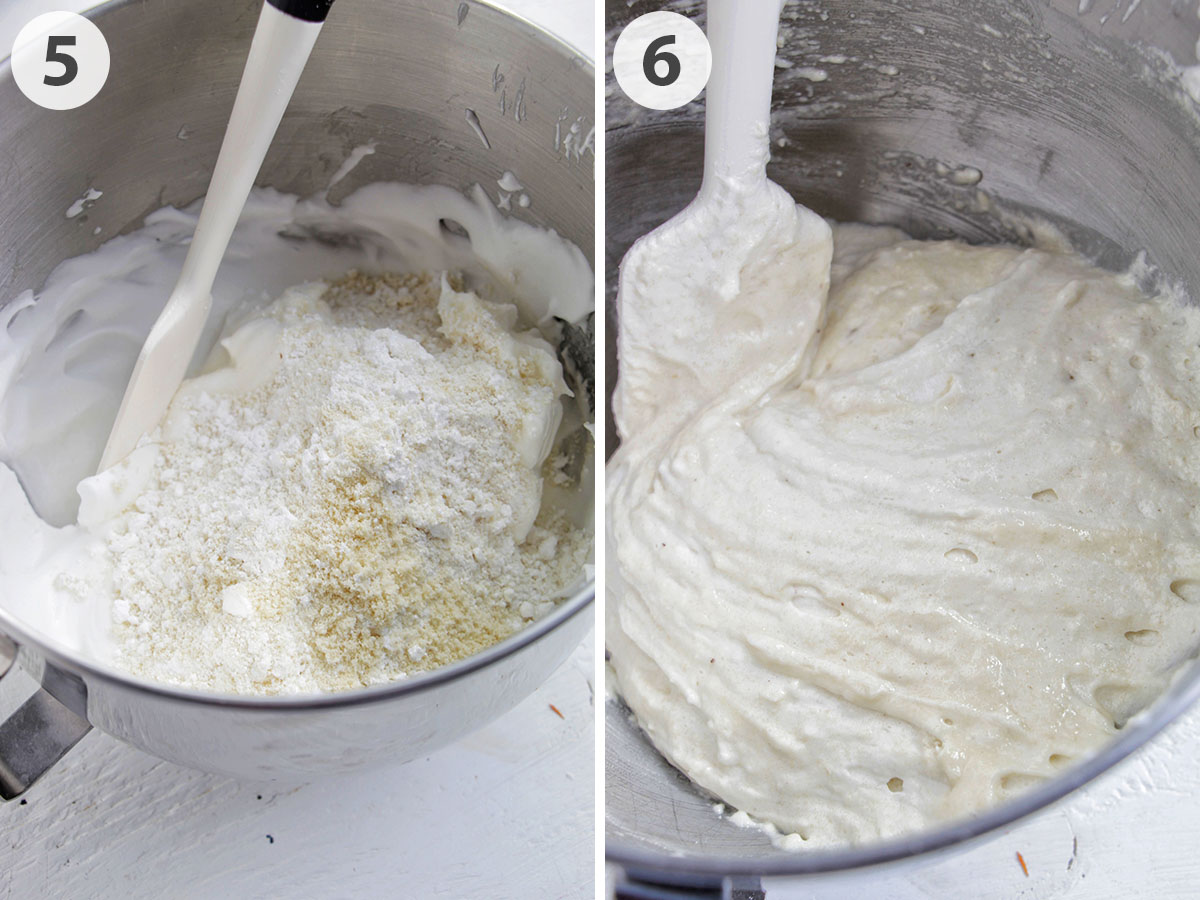
Pour a third of the sifted almond flour & confectioners sugar into the meringue mixture. Gently fold in the egg whites using a silicone spatula. I love using this large silicone spatula, especially if I'm making a large batch of macarons.
Continue mixing until all the meringue is fully incorporated and no dry bits of almond flour remain.
Evenly divide the batter into 3 medium-sized metal or glass bowls. Add 1-2 drops of gel food coloring.
In order to color or dye your macarons, you'll want to use gel food coloring. Liquid based food coloring will not work as it will cause your batter to be the incorrect consistency.
When you're adding gel food color to your macaron mix, be sure to do so slowly. Too much food color can cause your macarons batter to be ruined. Be sure to only add a few drops at a time until the desired color is reached.
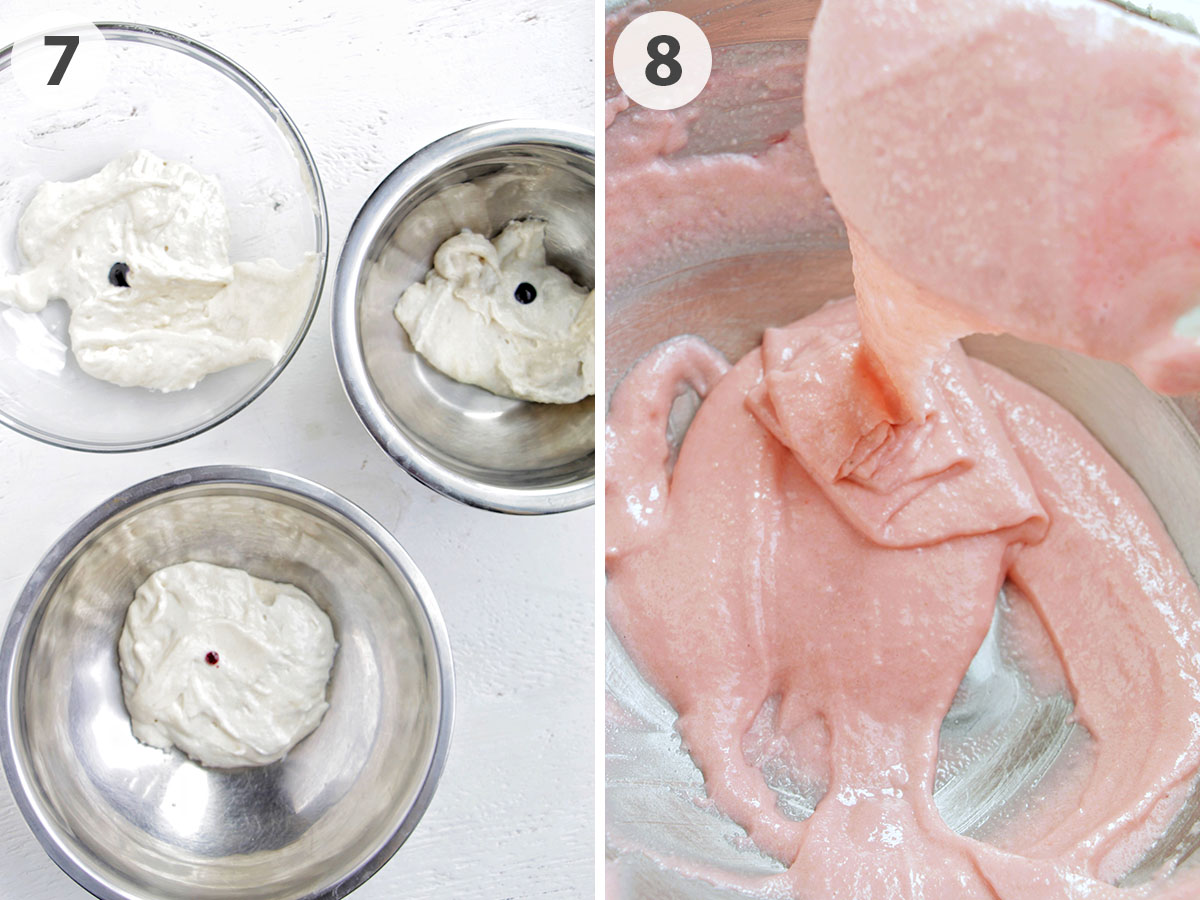
After adding the food coloring, begin working the batter until everything is fully incorporated. This is called the macaronage process. Slowly, spread the mixture along the side of the bowl, then wipe it back down. Be sure to do this gently.
Repeat this process until the mixture has reached a smooth, shiny, and flowing consistency. You can test this by lifting your spatula and seeing if the batter drops almost like lava.
Once the batter drops back into the bowl, it should take about 10-15 seconds for the ribbon that formed to "disappear" back into the rest of the batter.
The macaronage step is another crucial detail to get correct. With practice, you'll get better at knowing once it's properly macaronaged.
When in doubt, it's better to under macaronage. A batter that's too runny will not produce the macarons you're looking for.
Pipe The Macarons
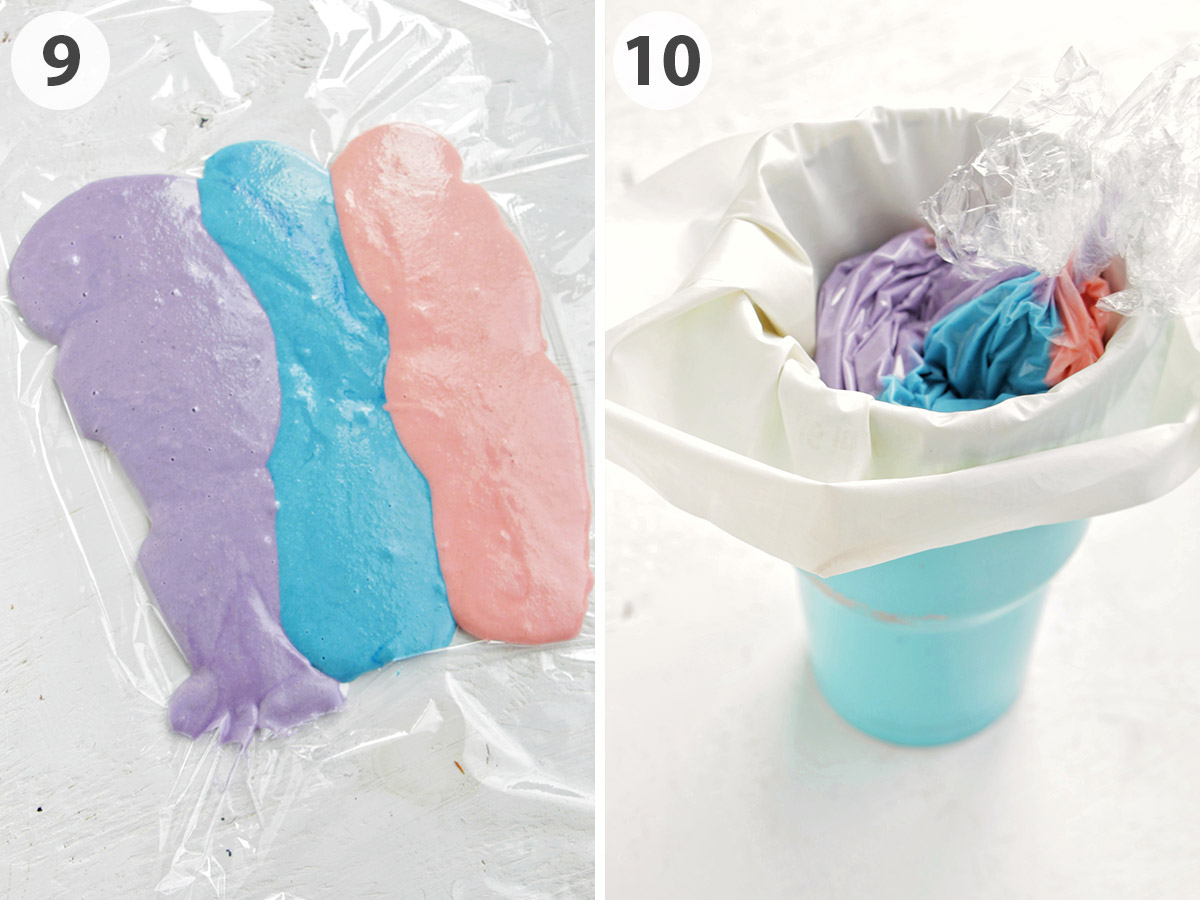
Spoon each color of batter in a straight line on a piece of plastic wrap. Carefully fold the plastic wrap up so all the colors are enclosed.
Then, snip off the bottom of one end of the plastic wrap and insert it into the prepared piping bag.
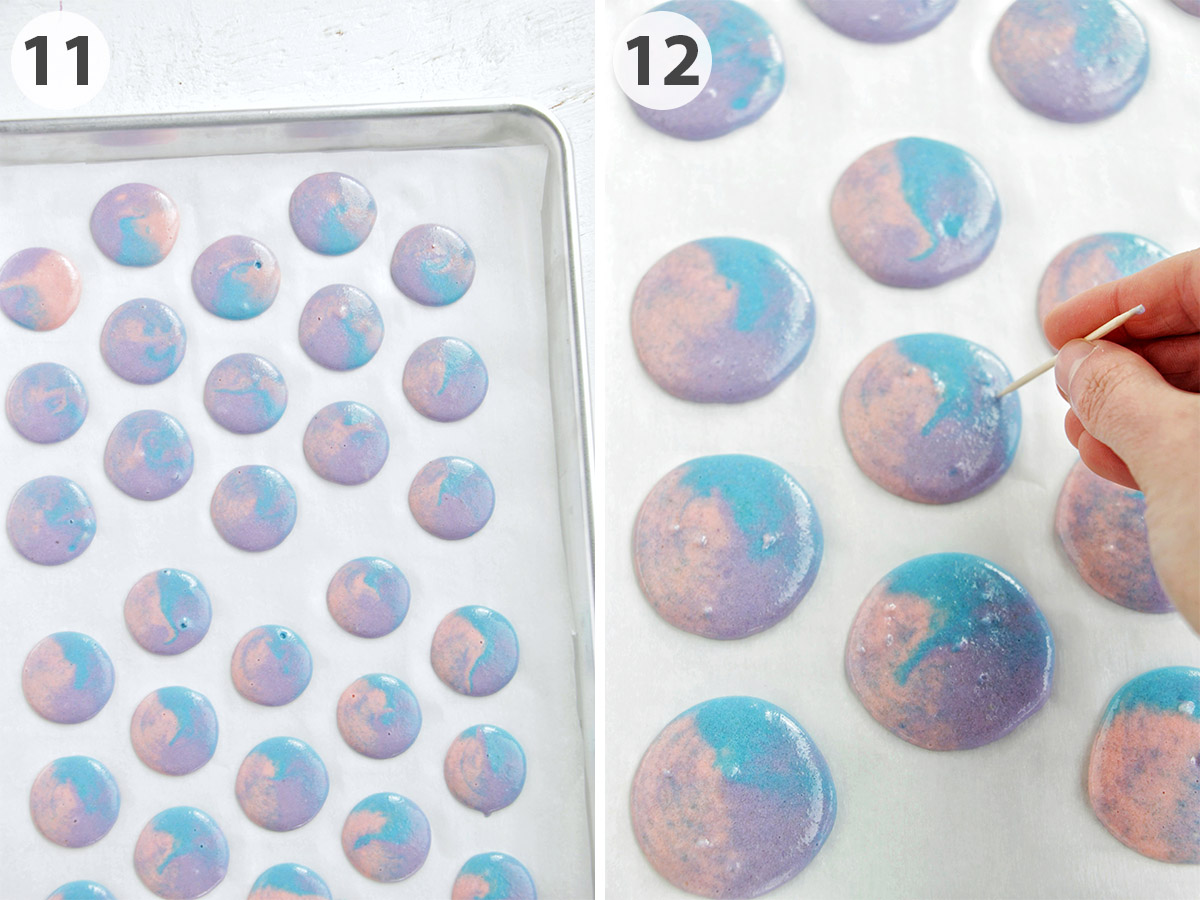
Hold the bag vertically, and gently pipe the batter out until it reaches the middle line of the circle template. Piping macarons takes time and practice.
Next, gently tap the sheet pan down on the counter a few times to release any air bubbles. Pop any air bubbles with a toothpick. This ensures your macarons won't crack during the baking process.
Allow the batter to sit on the counter and dry for 30 - 40 minutes, just until a thin "skin" develops and you can touch the tops without ruining the macaron. This resting time will vary depending on the humidity in your kitchen.
While the macarons are drying, heat your oven to 300°F.
Once the oven has preheated, bake the macarons for 15-18 minutes on the middle rack of the oven, rotating the pan halfway through the cooking process.
If you bake your macarons and notice any wrinkled tops, cracked shells, or browning, be sure to check out my oven temperature guide for further help.
Make The Buttercream Filling
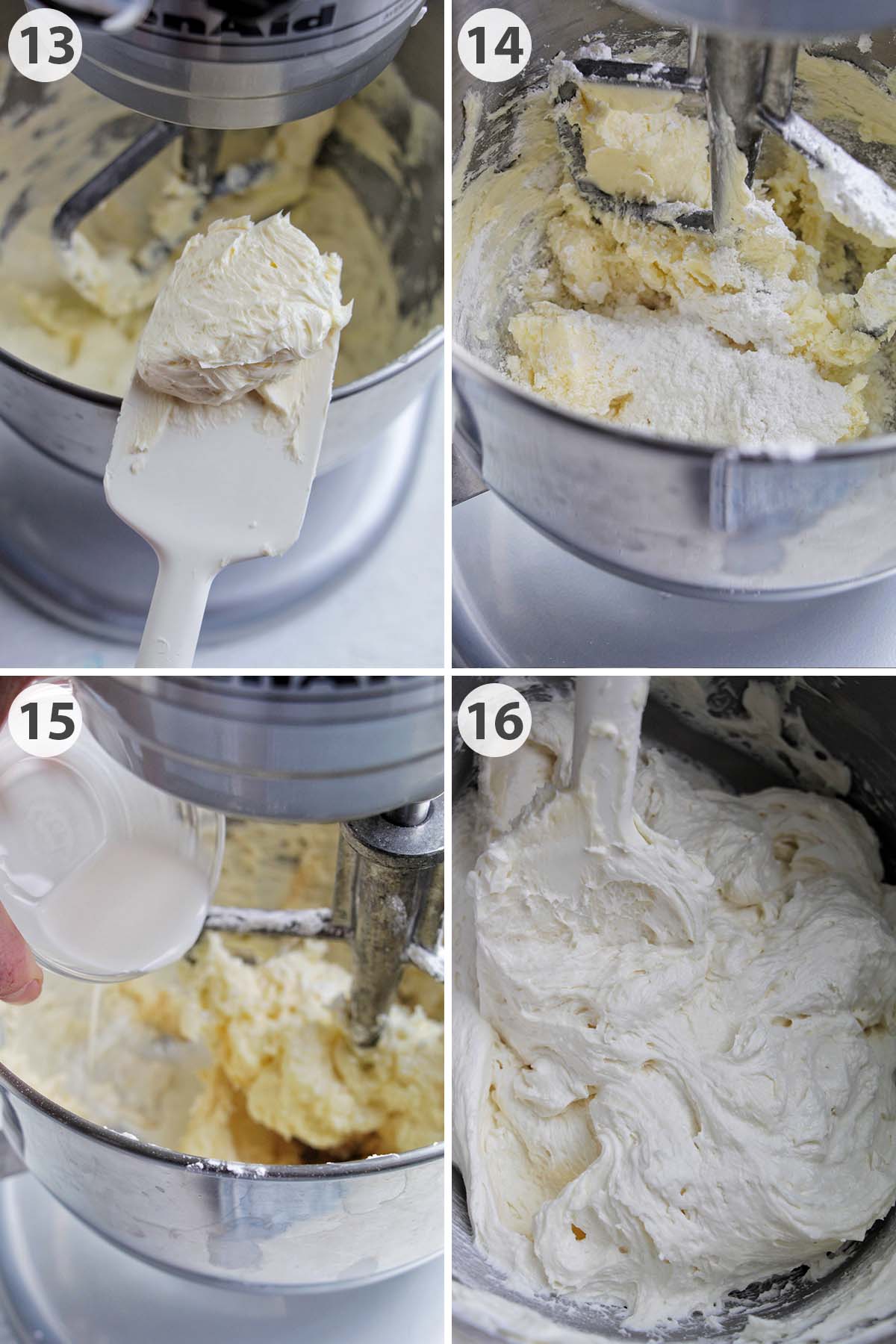
Now it's time for the fun part - making the macaron filling. To make this vanilla American style buttercream, add butter to a stand mixer fitted with a paddle attachment. Beat on medium-high speed for 2-3 minutes until it's light and fluffy.
With the mixer on low, gradually add the confectioners' sugar in multiple batches. Once that's combined, bump up the speed to medium, and add in heavy cream, vanilla extract, and salt.
Continue to mix for an additional 5 minutes on high speed until the frosting is light and fluffy.
Pipe The Filling

Finally, match up the cooled macaron cookies so they are paired with a similar size/shaped cookie.
Pipe buttercream on one side of the macaron shell using a Wilton 1M tip. Gently place the matching side on top of the buttercream.
Expert Tips
- It's best to allow your macarons to sit in the fridge overnight with the filling. This allows the macaron to slightly soften and develop a deeper flavor.
- If your macarons aren't developing a skin or drying out, it's likely because it's too humid. Many people often run dehumidifiers or air conditioning in the kitchen to help.
- Wondering how long to macaronage your batter? There's really not a set time. It all depends on the recipe, your specific ingredients and environment, and even the amount of batter you are making. If you're in doubt while macaronaging, it's better to undermix a little bit. Overmixing causes more detrimental mistakes that are more noticeable (cracking, no feet development, etc.).
- Don't skip the resting stage. Most French macarons need time to rest so they form a skin on top. This helps prevent the macarons from cracking.
French Macaron Troubleshooting Tips
The oven is too hot. Ovens that are too hot (typically anything over 325°F, although even that can be too hot for some macaron recipes like this), can cause flat tops or wrinkly macaron shells. Try bringing the temperature down 5-10°F at a time.
You over macaronaged your batter. The batter should be a lava-like consistency (see my video for an example). You can test this by lifting your spatula and seeing if the batter drops almost like lava. Once it drops off the spatula, the batter that was dripped should fade back into the batter within 15-30 seconds. When in doubt, don't overmix.
If you're still having trouble, check out my troubleshooting guide for flat macarons or wrinkled shells.
You didn't rest your macarons long enough. To fix this, you'll need to make sure a "skin" has formed on the macaron. You can test this by touching the tops. If you can touch the top without ruining the macaron or making a dent, you're probably good to go! Resting time will vary depending on the humidity.
You have air bubbles in the macarons that burst during the baking process. To fix this, gently tap the sheet pan down the counter a few times to release any air bubbles. Pop any air bubbles with a toothpick.
Your meringue is under-whipped. French meringue needs to be properly beaten in order to form a strong macaron. Make sure that you're fully beating your meringue to stiff peaks. To test the meringue stiffness, pull the whisk out. A stiff peak should stand straight up (no curl at the tip). Signs that you're ready to test the stiffness include seeing lines left from the beaters in your eggs. In addition, the meringue starts to almost ball up inside the whisk beater attachment. You'll also know it's ready because you can fully flip the bowl over and nothing moves or falls out.
The oven is too hot. To fix this, make sure you have an oven thermometer to measure the exact temperature of your oven (it should be placed in the middle of the center rack of your oven for a proper reading). Try lowering the oven temperature by 5°F at a time. Test until there is no more cracking.
If you're still having trouble, check out my troubleshooting guide for cracked macaron tops.
Your meringue is under-whipped. French meringue needs to be properly beaten in order to form a strong macaron. Make sure that you're fully beating your meringue to stiff peaks. To test the meringue stiffness, pull the whisk out. A stiff peak should stand straight up (no curl at the tip). Signs that you're ready to test the stiffness include seeing lines left from the beaters in your eggs. In addition, the meringue starts to almost ball up inside the whisk beater attachment. You'll also know it's ready because you can fully flip the bowl over and nothing moves or falls out.
The macaron shells are underbaked. If you don't give your macaron shells enough time to bake in the oven, a sturdy outside will never develop. Make sure to check that the macarons are done before putting them out of the oven. If you touch the shell and it wiggles or is still sticky/wet, you know they need longer to bake.
The batter was over-mixed in the macaronage process. This will cause the macarons to spread out wide, rather than rising up vertically. To fix this, work on the macaronage process. The macaronage stage, which refers to working your batter to the proper consistency, is a technique that takes a while to master. The batter should be a lava-like consistency (see my video for an example). You can test this by lifting your spatula and seeing if the batter drops almost like lava. Once it drops off the spatula, the batter that was dripped should fade back into the batter within 15-30 seconds. When in doubt, don't overmix.
Your meringue is over-whipped. Over-whipped meringue will produce almost too much air in your macrons, thus causing them to rise and expand outward, creating these ruffled feet. Make sure to get just to stiff peaks, and not any further. Over-whipped meringue tends to be a little dull (not as shiny). Watch out for this!
The oven temperature is too hot. Similar to the flat and wrinkly macaron shells, a hot oven will cause the macarons to spread out too much. Temperature can be a cause for ruffled feet, along with not using parchment paper or a silicone mat to help evenly distribute heat.
If you're still having trouble, check out my troubleshooting guide for ruffled macaron feet.
Your oven is too hot. To fix this, make sure you have an oven thermometer to measure the exact temperature of your oven (it should be placed in the middle of the center rack of your oven for a proper reading). Try lowering the oven temperature by 5°F at a time.
The macarons have baked too long. Turn on your oven light (but don't open the oven door) to keep an eye on the macarons while they're baking.
This is the last troubleshooting problem you should worry about. Before perfecting your macarons so they don't have hollows, make sure all the other properties are correct.
The meringue is over/under-whipped. In order to prevent hollows, you need the perfect consistency of meringue before starting the macaronage process. Oftentimes, adding in an acid, like cream of tartar, can help stabilize your meringue and allow more time for the air to get incorporated.
The batter was over or under-mixed in the macaronage process. The macaronage stage, which refers to working your batter to the proper consistency, is a technique that takes a while to master. If you've worked the batter to a lava-like consistency and you're still getting hollow shells, try working it a tad less.
Your oven temperature is too high/low. Oven temperature plays a big role in hollow macarons. Unfortunately, due to the capabilities of home conventional ovens, you have to test and play around with the temperature to get your macaron shells perfect. Most recipes suggest baking macarons anywhere from 275°F - 325°F. Test these temperature ranges out with your home oven and an oven thermometer to see what works best.
If you're still having trouble, check out my troubleshooting guide for hollow macarons.

More Macaron Recipes & Guides
If you enjoyed these tie dye macarons, don't forget to check out my other favorite macarons, including over 30+ of the best macaron recipes:
Love this recipe? Please leave a 5-star ⭐⭐⭐⭐⭐ rating in the recipe card below. Don't forget to follow along on Instagram, Facebook, YouTube, and Pinterest for more recipes.

Tie Dye Macarons
Equipment
- silicone mat or parchment paper
- pastry bag with ½ inch round tip
Ingredients
For the Macarons
- 124 grams egg whites room temperature (about 4-5 large eggs)
- ½ teaspoon cream of tartar
- 148 grams super fine almond flour
- 222 grams confectioners' sugar
- 46 grams granulated sugar
- gel food coloring (3 colors)
For the American Buttercream
- 1 cup (224 grams) unsalted butter room temperature
- 2 ½ cups (285 grams) confectioners' sugar measured, then sifted
- 2 tablespoons (25 grams) heavy cream
- 1 teaspoon (4 grams) vanilla extract
- pinch of fine sea salt
Instructions
Prep Work
- Separate egg whites from yolks and allow egg whites to come to room temperature.
- Measure dry ingredients using a kitchen scale. Sift almond flour and confectioners sugar together into a large metal or glass bowl.
- Wipe down all bowls and whisk attachment with a little white vinegar on a paper towel to remove any leftover oils.
- Print off the macaron template. Place them on a sheet pan underneath a piece of parchment paper.
- Prepare your piping bag with a round tip. Push part of the side of the piping bag into the piping tip to ensure nothing leaks out. Set the bag inside a tall glass, and pull the remaining top of the piping bag out over the outside of the glass to make pouring the batter easy and clean.
For the Macarons
- Add in room temperature egg whites to a large bowl, along with cream of tartar. Whip on medium-low speed with a handheld mixer until eggs are very foamy. Then add ⅓ of the granulated sugar at a time, and increase the speed to medium high.
- Once all the granulated sugar is incorporated, allow egg whites to continue to whip up on medium-high speed until stiff peaks form (you'll notice the meringue starts to ball up inside the whisk). To test the meringue stiffness, pull the whisk out. A stiff peak should stand straight up (no curl at the tip). You'll also know it's ready because you can fully flip the bowl over and nothing moves or falls out. Make sure not to over beat the meringue at this stage.
- Pour a third of the sifted almond flour & confectioners sugar into the meringue mixture. Gently fold in the egg whites using a silicone spatula. Continue until all the meringue is fully incorporated and no dry bits of almond flour remain on the bottom of the bowl.
- Evenly divide the batter into 3 medium-sized metal or glass bowls. Add 1-2 drops of gel food coloring. Then, begin working the batter until everything is fully incorporated (this is called the macaronage process). Slowly, spread the mixture along the side of the bowl, then wipe it back down. Be sure to do this gently. Repeat, until the mixture has reached a smooth, shiny, flowing consistency. You can test this by lifting your spatula and seeing if the batter drops almost like lava. Once the batter drops back into the bowl, it should take about 10-15 seconds for the ribbon that formed to "disappear" back into the rest of the batter.
- Spoon each color of batter in a straight line on a piece of plastic wrap. Carefully roll the plastic wrap up so all the colors are enclosed. Cut off the tip of one end of the plastic wrap, and insert it open side down into a prepared piping bag. Hold the bag vertically, and gently pipe the batter out until it reaches the middle line of the circle template. Continue until no batter remains.
- Gently tap the sheet pan down the counter a few times to release any air bubbles. Pop any air bubbles with a toothpick. Allow the batter to sit on the counter and dry for 30 - 40 minutes, just until a thin "skin" develops, and you can touch the tops without ruining the macaron. This resting time will vary depending on the humidity (make sure you don't let them rest too long by periodically checking on them). While the macarons are drying, heat oven to 300°F.
- Bake for 16 - 20 minutes on the middle rack of the oven, rotating the pan halfway through the cooking process. Remove from the oven and allow to cool for 5 minutes on the pan. Then, move the silicone mat or parchment paper to a cooling rack until completely cooled.
For the Amercian Buttercream
- Add the paddle attachment to your stand mixer. To the stand mixer bowl, add butter. Beat on medium-high speed for 2-3 minutes until light and fluffy.
- With the mixer on low, gradually add in confectioners' sugar.
- Bump up the speed to medium, and add in heavy cream, vanilla extract, and salt. Continue to mix for an additional 5 minutes until the frosting is light and fluffy.
- Match up macaron cookies so they are paired with a similar size/shaped cookie. Pipe buttercream on one side of the macaron shell using a Wilton 1M tip. Gently place the matching side on top of the buttercream.
- Mature the macarons with the filling in the refrigerator overnight. This will allow the macarons to slightly soften and develop a deeper flavor.

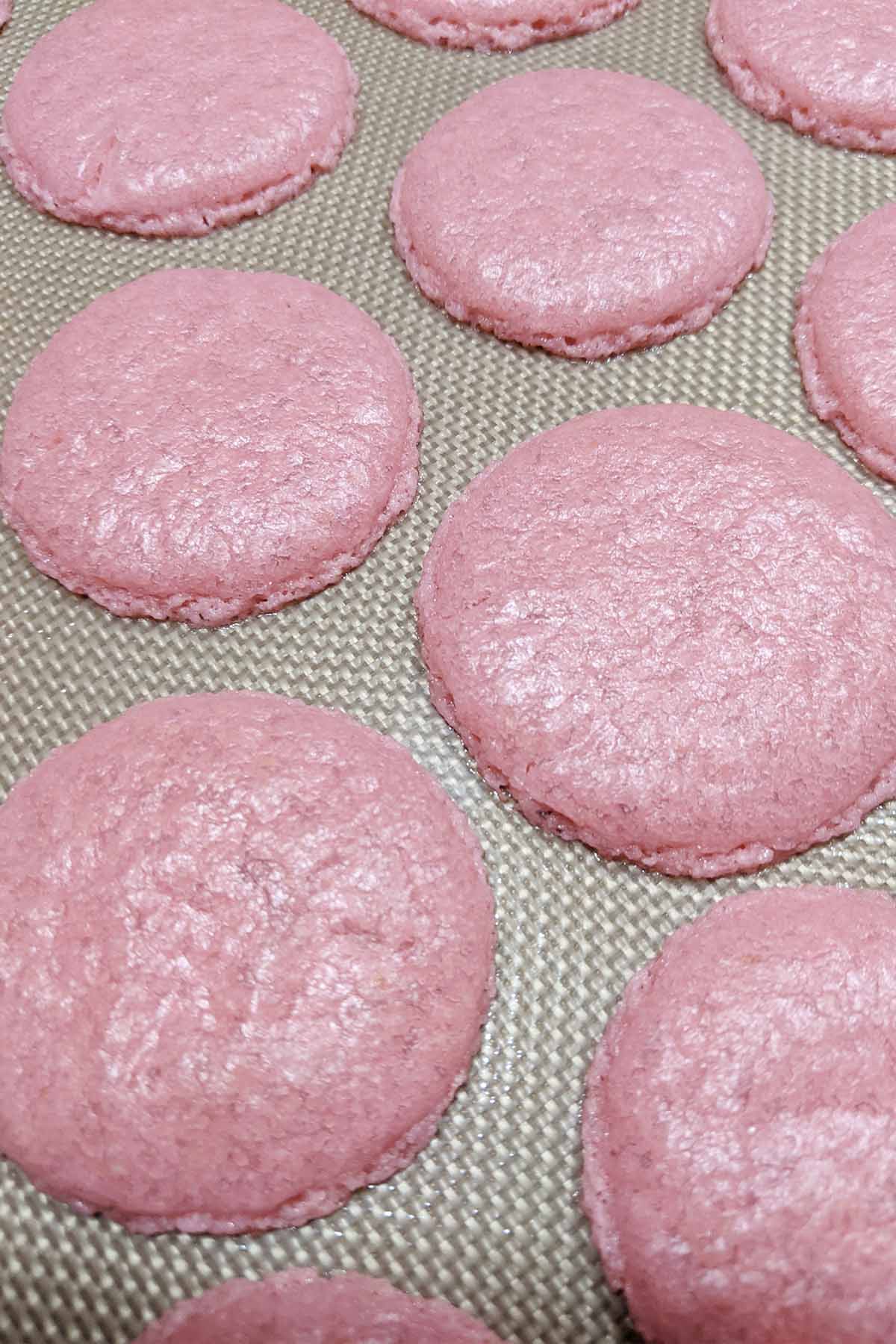
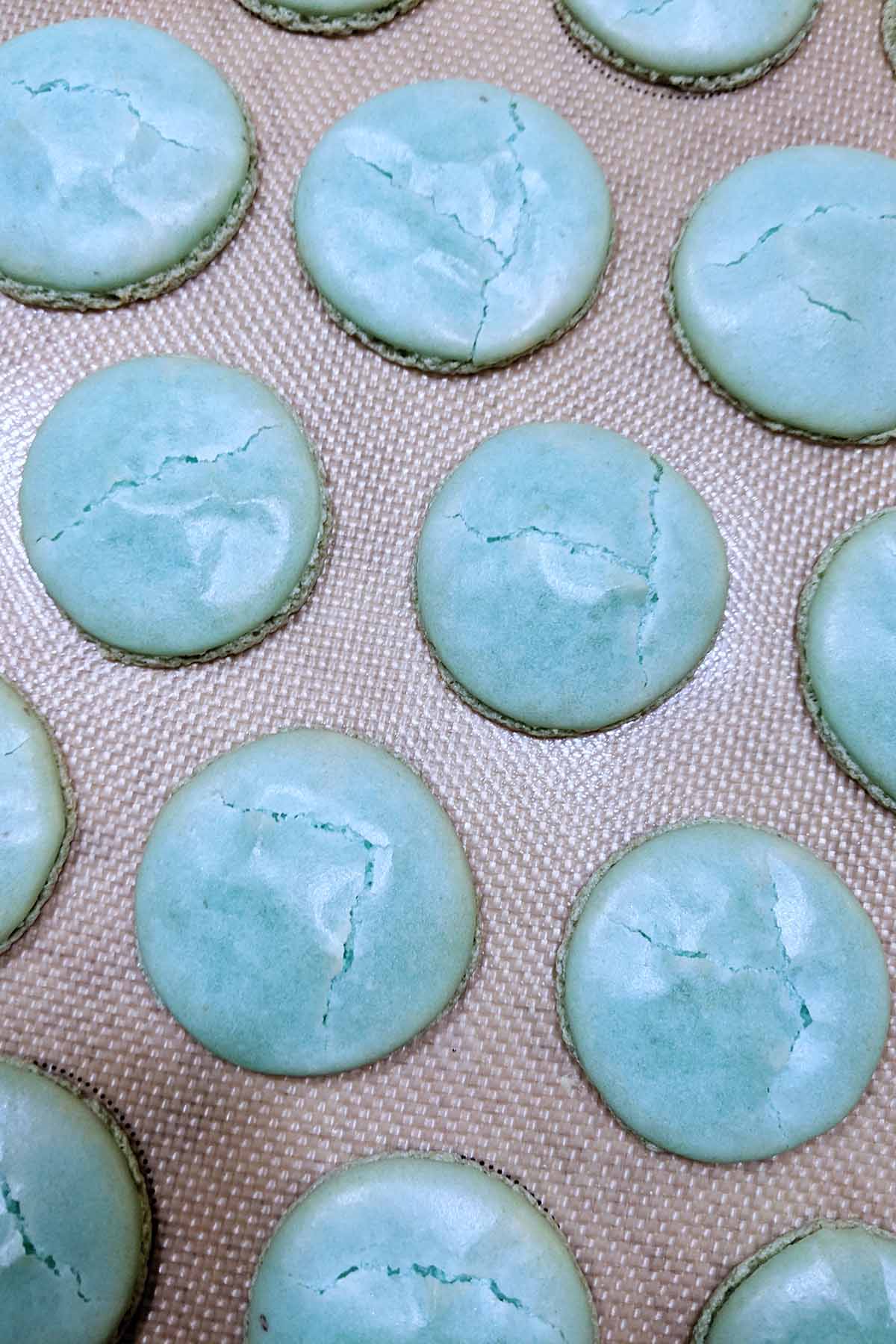
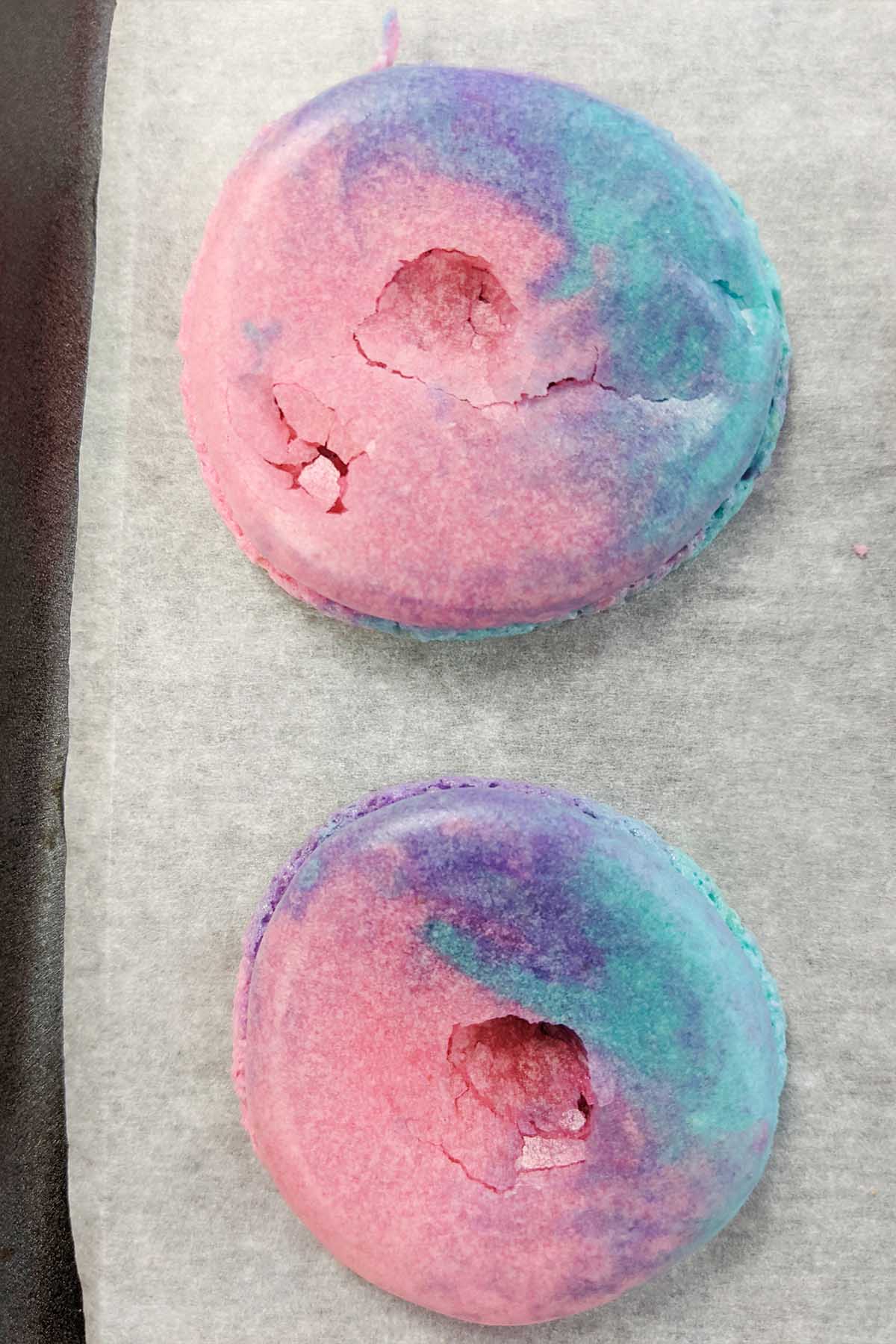
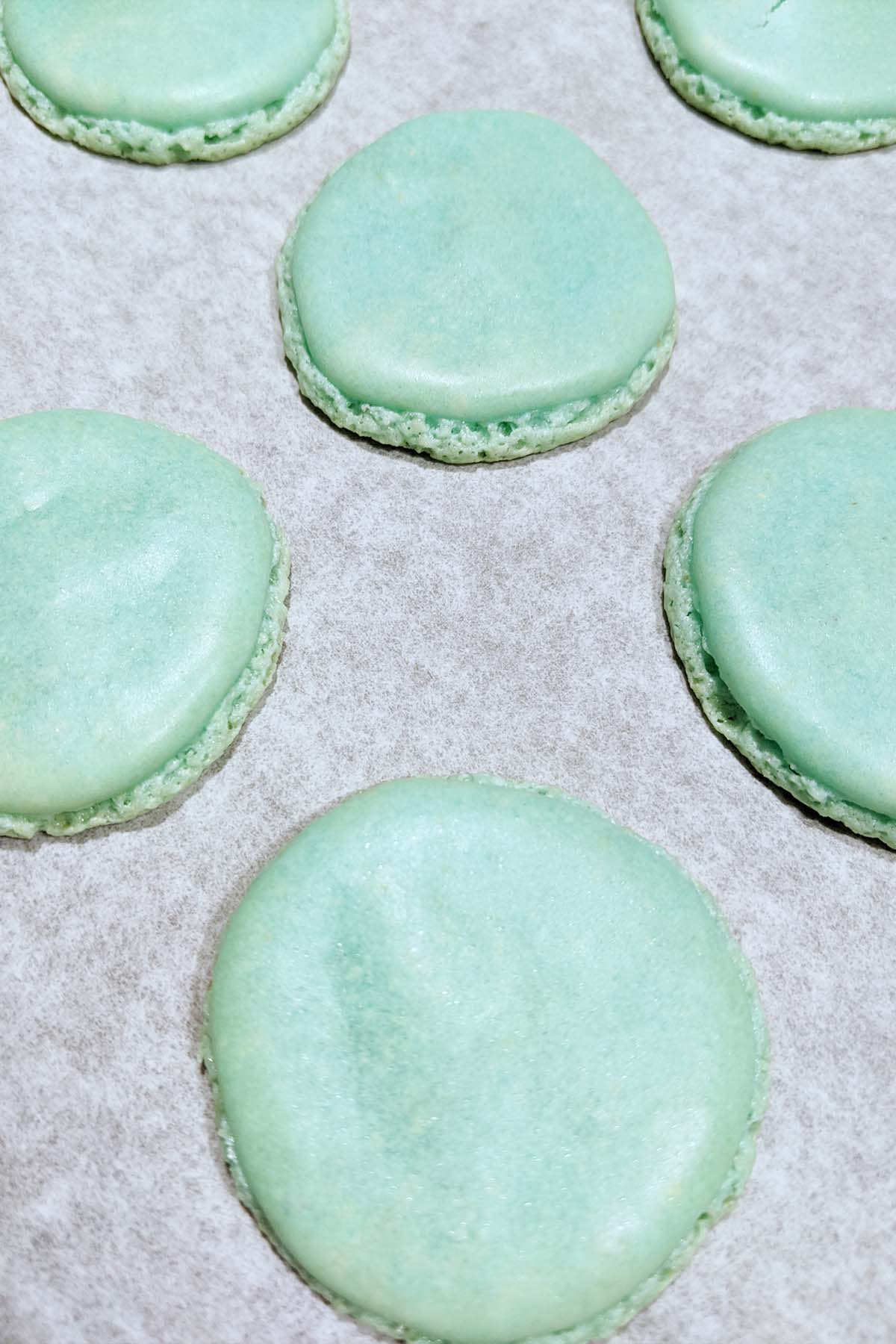
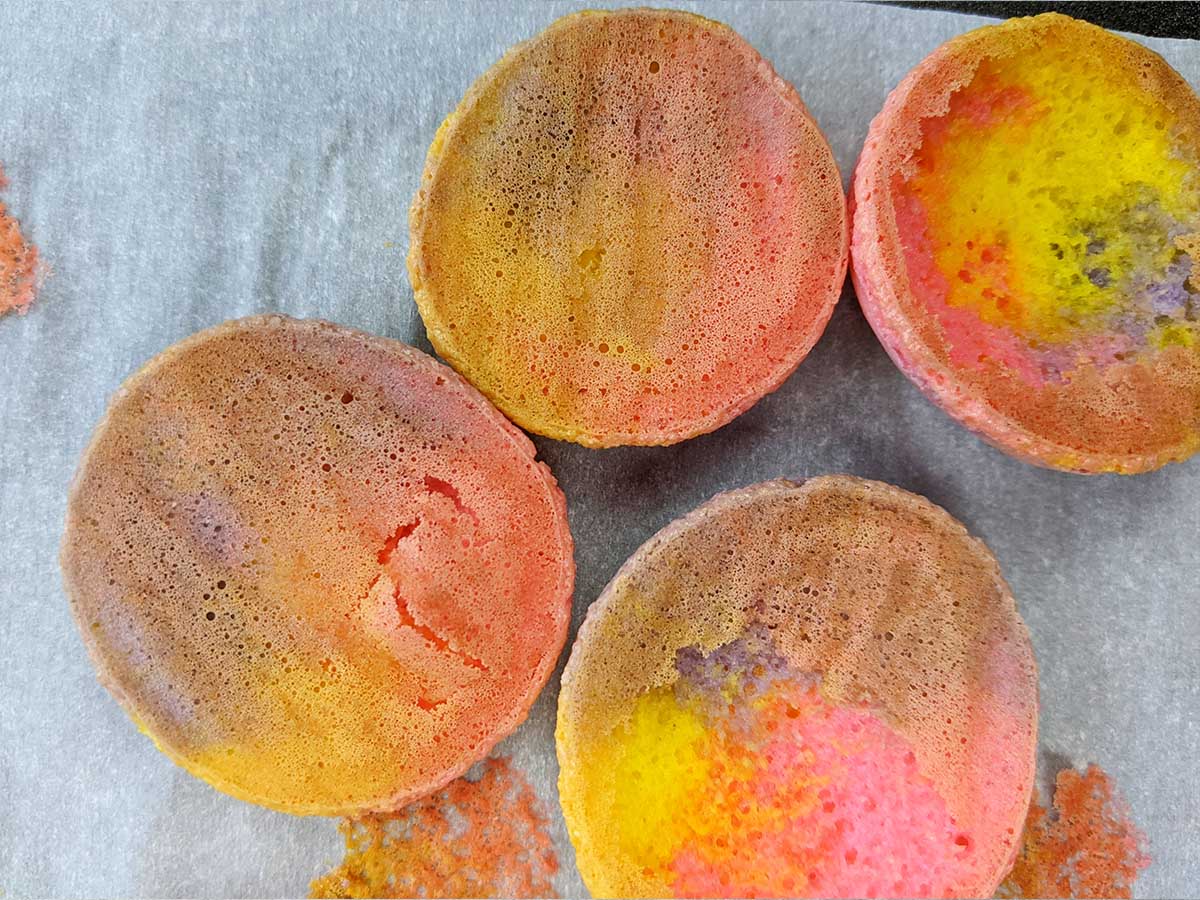
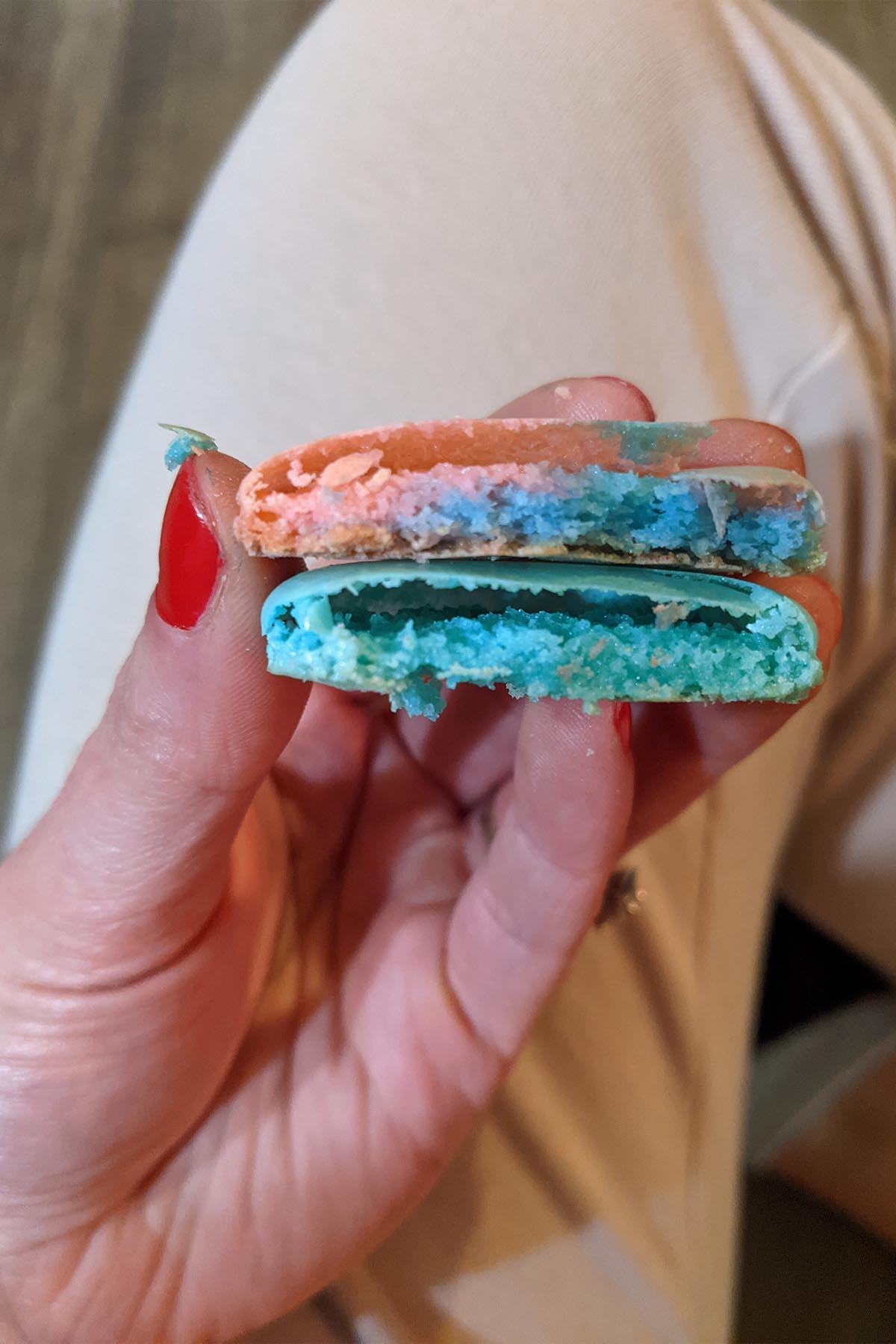
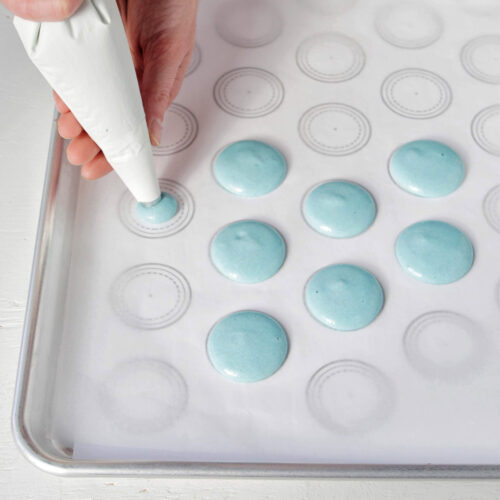
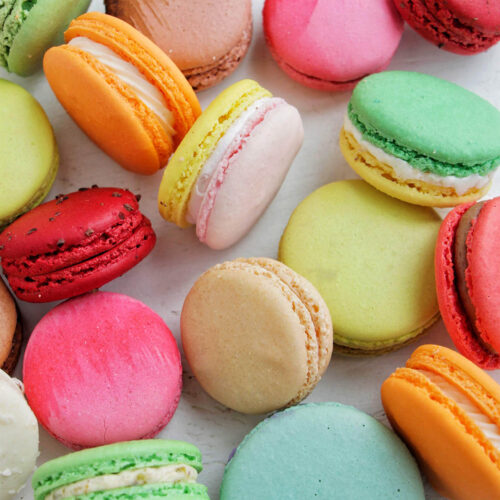
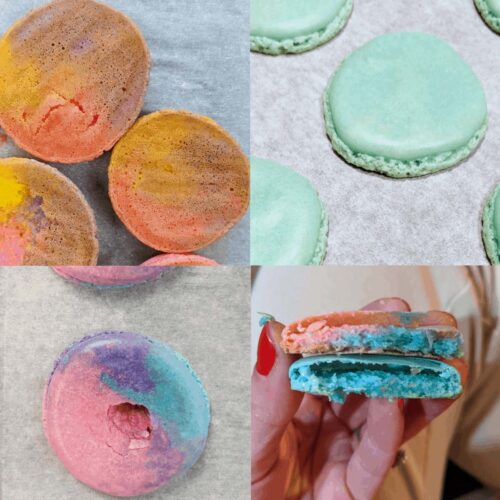
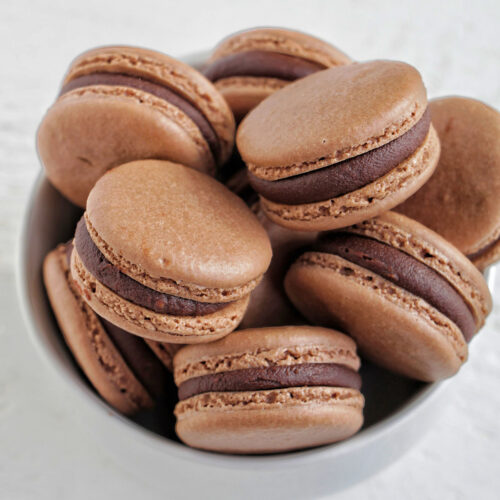
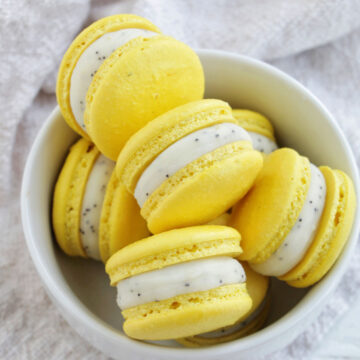
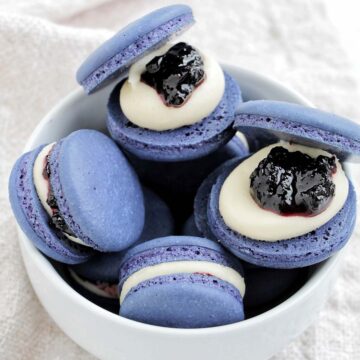
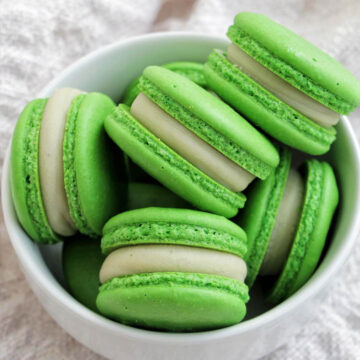
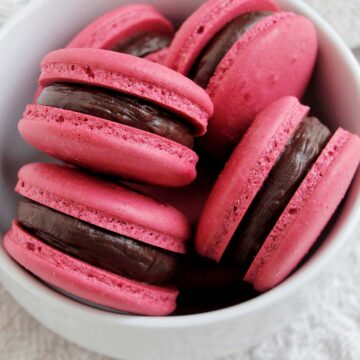
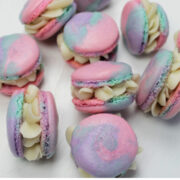
Abby M
The macarons tasted really good and the instructions were thorough! The tips she gave were very helpful and I will definitely be making these again!
Sue
My first attempt at making macarons was to carefully read your tips and following your recipe, although I halved it because I was intimidated…I didn’t add color, but did put sugar crystals on half the macarons. I was very surprised and pleased with the results, although I haven’t filled them yet. Thank you for such detailed explanations as they really helped get me through the “tricky” parts! I will definitely be making them again!
Jessica Mode
That makes me SO happy!! Macarons can definitely be intimidating, but I'm so glad you just went for it and they turned out great!